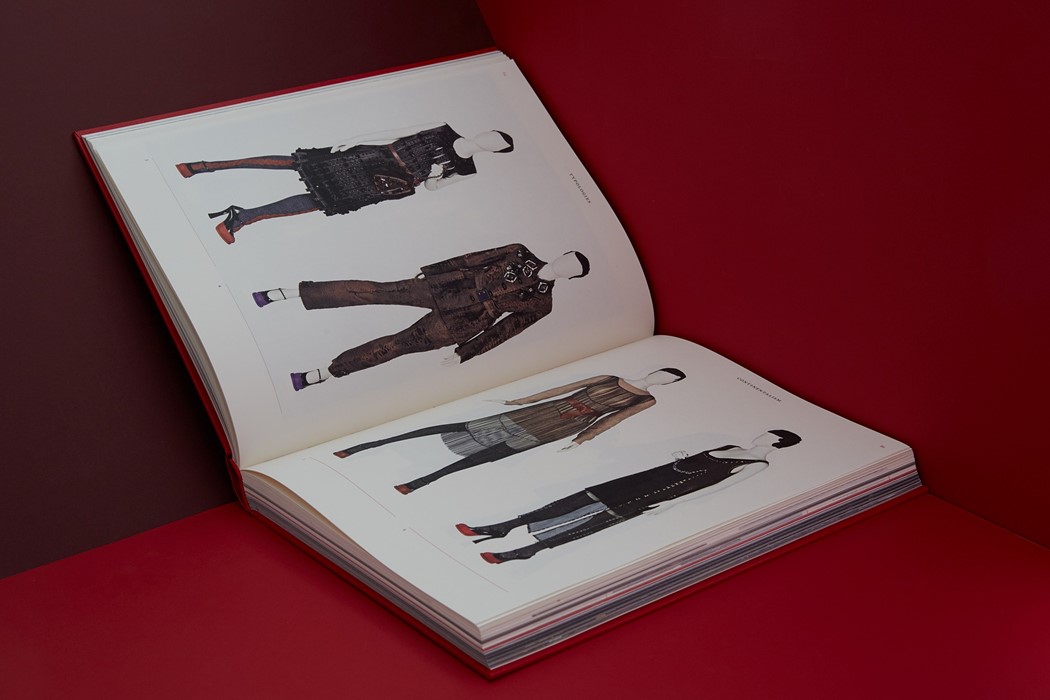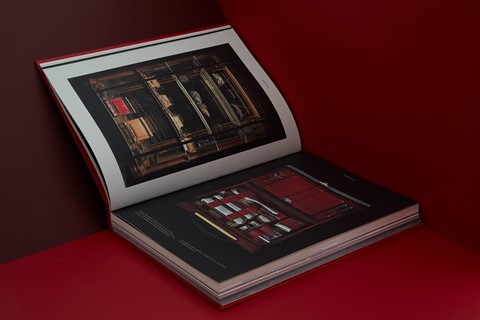The history, heritage and preoccupations of Prada are exquisitely laid out in the new book Pradasphere
This week saw the release of a new Prada publication: Pradasphere, a "collection of archival objects arranged to read the complex, often intertwined, obsession of one of the world's most influential designers." The book follows the brand's 2014's takeover of department store Harrods, where an exhibition of the brand was displayed alongside a Milanese cafe, a pop-up store and a 40-window display. Visually tracing the development of the brand from its 1913 conception to its contemporary incarnation as a powerhouse in fashion, art and design, Pradasphere not only includes documentation of items of clothing but also the ephemera that goes alongside: from fashion show invitations to film stills. Here, we look at some of our favourite aspects explored within the book, documented for AnOther by Maxyme G. Delisle.
Pradasphere is a giant, 326-page hardcover that comes enveloped in a dark red slipcase. Separated into six zones: Origins, Typologies, Speciments, Construction, Evolution and Observation, Mrs. Prada herself explained that the object "demonstrates the way we think about our work, and all of the different forces that shape that thinking: our origins, the things we have made, the creative input of our collaborators, the insights drawn from parallel disciplines such as art, film, and architecture, and the fundamental influence of traditional craftsmanship and materials mixed with contemporary manufacturing and technology." Essentially, it is a visual dictionary of the brand's references, alongside an exploration of the distinct themes that have come to define its creations: topics like Excessivity, Animality and Modernity.

Heritage
Originally established by Mario Prada as a Milanese boutique selling leather goods, in 1979 Miuccia Prada inherited the brand and, after creating a series of nylon backpacks (using the fabrication that were originally used by her grandfather for steamer trunks), she developed the brand into the fashion house that it is today. Pradasphere offers us an insight into the original pieces that were sold in the first store, showing everything from the saffiano leather wallets (which are still in production, albeit in different designs) to purses with ivory fastenings in the shape of satyrs and the signature tissue paper that they were wrapped in.

Femasculinity
A subject which repeatedly preoccupies Miuccia Prada is femininity, and its interaction with power. The appropriation of menswear styles, blurring of gender binaries, and subversion of typical femininity have all become defining elements of the brand – and, as Mrs Prada explained in her Pre-Fall 2015 shownotes (where she sent Menswear 2015 and Womenswear Pre-Fall down the same runway), "shows are the perfect moment to analyse this subject more deeply to measure what the genders share, what they take from each other." By positioning collections from 1994 to current-day alonside one another, the continued obsession with femasculinity becomes clear even to the Prada novice.

Synthetic
As was clearly examined in the most recent collection, Prada's interest in the synthetic is another defining code of the house. From the deliberate artifice of A/W15 to Mrs Prada's continued re-invention of utilitarian black nylon, subverting notions of luxury and perfection is key to the Prada brand which "attacks against the status quo that celebrate otherworldly elements and superhuman enhancements."

Ephemera
Prada's show invitations often offer clues to the upcoming collection: from specially-commissioned artworks to embossed slips of leather, they are as carefully conceived as the garments that follow. By documenting a history of their multifarious communications, Pradasphere reminds us of the consideration that goes into every element of the brand, and their influence not only within the sphere of fashion but also within graphic design.

Pradasphere is published by Abrams Books and is available now.










